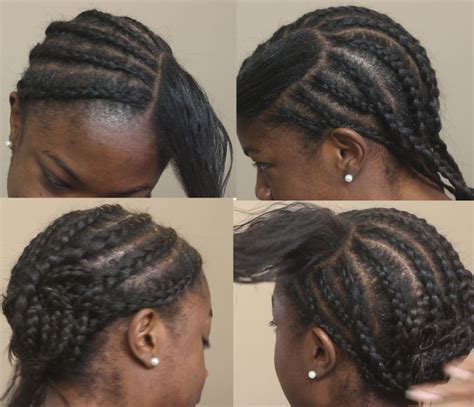Introduction
Sew in braids, also known as track, are a versatile and protective hairstyle that can be customized to suit any face shape and hair texture. They involve weaving extensions into your natural hair, creating a seamless and long-lasting look. This article provides a comprehensive guide to sew in braid patterns, including step-by-step instructions, different pattern types, and tips for choosing the best pattern for your needs.

Types of Sew In Braid Patterns
1. Basic Center Part
This classic pattern involves parting your hair down the middle and sewing in wefts along each side. It’s a versatile pattern that suits most face shapes and hair textures.
2. Zigzag Part
For added volume and movement, try a zigzag part. This pattern involves creating a series of V-shaped sections and sewing in wefts along the edges.
3. Crisscross Part
Create a unique and eye-catching look with a crisscross part. This pattern involves parting your hair into four or more sections and sewing in wefts in an intertwining pattern.
4. Butterfly Part
For a playful and feminine touch, opt for a butterfly part. This pattern involves creating a butterfly-shaped part in the middle of your scalp and sewing in wefts around the edges.
5. Spiral Part
Add a touch of drama and dimension with a spiral part. This pattern involves parting your hair into small circular sections and sewing in wefts in a spiral pattern.
Step-by-Step Guide to Sewing In Braids
Materials:
- Hair extensions
- Sewing needle and thread
- Rattail comb
- Curved needle (optional)
- Clips
Instructions:
- Prep your hair: Wash, condition, and blow dry your hair. Part your hair according to your desired pattern.
- Create cornrows: Braid small, tight cornrows along the part lines. These cornrows will provide a base for the sew-ins.
- Attach wefts: Take a weft of hair extension and thread it onto your sewing needle. Insert the needle into the cornrow at the desired point, pulling it through to the other side.
- Sew in the weft: Wrap the thread around the needle and pull it through the cornrow, creating a small knot. Continue sewing the weft in this manner until it is completely attached.
- Repeat: Repeat the process for the remaining wefts, ensuring that they are evenly spaced.
- Trim and blend: Once all wefts are sewn in, trim any excess hair and blend the extensions with your natural hair using styling products.
Choosing the Best Sew In Braid Pattern for You
When choosing a sew in braid pattern, consider the following factors:
- Face shape: Certain patterns, such as the zigzag part, can help to balance out a round or square face.
- Hair texture: If you have thick or coarse hair, a pattern with more wefts may be necessary to achieve a full and voluminous look.
- Lifestyle: If you prefer a low-maintenance hairstyle, opt for a basic pattern that requires less upkeep.
Benefits of Sew In Braids
Sew in braids offer numerous benefits, including:
- Protective: They protect your natural hair from heat, chemicals, and manipulation, promoting healthy hair growth.
- Versatile: They can be styled in a variety of ways, from sleek ponytails to voluminous curls.
- Long-lasting: They can last for up to 8 weeks with proper care, saving you time and money on frequent salon visits.
- Low-maintenance: Compared to other protective hairstyles, sew in braids are relatively low-maintenance, requiring only occasional tightening and touch-ups.
Tips for Maintaining Sew In Braids
- Wash gently: Use a sulfate-free shampoo and conditioner and avoid scrubbing your scalp too vigorously.
- Avoid heat: Minimize the use of heat styling tools to prevent damage to your natural hair and extensions.
- Moisturize regularly: Apply leave-in conditioners and oils to keep your hair and scalp hydrated.
- Tighten regularly: Schedule regular tightening appointments every 2-3 weeks to prevent the braids from loosening.
- Take breaks: Allow your natural hair to rest after 8-10 weeks of wearing sew in braids.
Conclusion
Sew in braid patterns offer a wide range of options to enhance your hairstyle and protect your natural hair. By following the step-by-step instructions and choosing the best pattern for your needs, you can achieve stunning and long-lasting results. Remember to maintain your sew in braids properly to maximize their benefits and enjoy a beautiful, healthy hairstyle.
Additional Information
Statistics:
- According to the American Academy of Dermatology, hair grows an average of 0.5 inches per month.
- The National Hair Loss Association reports that over 50% of women experience hair loss at some point in their lives.
- A study published in the Journal of Cosmetic Dermatology found that sew in braids can significantly reduce the stress on natural hair, leading to improved hair health.
“Weavolution”:
Weaving together the techniques of sewing and braiding, “weavolution” is a new word that represents the fusion of these two hair styling techniques. This innovative approach combines the versatility of braids with the durability of sewn-in extensions, creating endless possibilities for unique and protective hairstyles.
